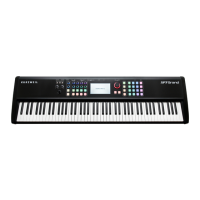40
Chapter 5. FX Editing
Chapter 5
5-1-3-1 Rotary
Rotary reproduces the effect of a rotating speaker and
is commonly paired with classic tonewheel organ
sounds. There are 8 detailed settings:
Default Speed - Select the default rotation speed of the
speaker, Slow or Fast.
Mic Angle - Select the angle of the microphone relative
to the front of the rotating speaker. It can be set to 45
degrees, 90 degrees, or 135 degrees.
5-1-3-2 Chorus
The Chorus effect provides 5 parameter settings:
Waveform - Select from 3 waveforms shapes: Triangle,
Sine, and Async sine.
Rate - Determines the frequency of signal modulation.
Higher values equal faster rates.
Depth - Sets the depth of the pitch modulation. Higher
values equal wider pitch variations.
Delay - Adds delay in front of the modulated signal.
5-1-3-3 Vibrato
The Vibrato effect provides 3 parameter settings:
Waveform - Select from 2 waveforms shapes: Triangle
and Sine.
Rate - Determines the rate of vibrato. Higher values
equal faster modulation rates.
Depth - Sets the depth of the pitch modulation. Higher
values equal wider pitch variations.
Accel.Rate - The Acceleration Rate equals the time it takes for the speaker to transition from its Slow to Fast
Rate settings.
Brake Rate - The Brake Rate equals the time it takes for the speaker to transition from its Fast to Slow Rate
settings.
Slow Rate - The Slow Rate defines the rate of rotation for the speaker's Slow rotation speed. Lower values spin
the speaker more slowly. Higher values equate to a faster rotation.
Fast Rate - The Fast Rate defines the rate of rotation for the speaker's Fast rotation speed. Lower values spin
the speaker more slowly. Higher values equate to a faster rotation.
Radius- Radius sets the effective sizes of the rotating speakers. Lower values equal a smaller size.
Directivity - Directivity a function related to the dispersion of the horn. Lower values produce a narrower field
where higher values generate and increasingly wider and more pronounced doppler effect.
Higher values equal longer delay line times and thus phase variations.
Dry/Wet - Determines the balance between unaffected (dry) and effected (wet) signals. Higher values equal a
more effected signal.

